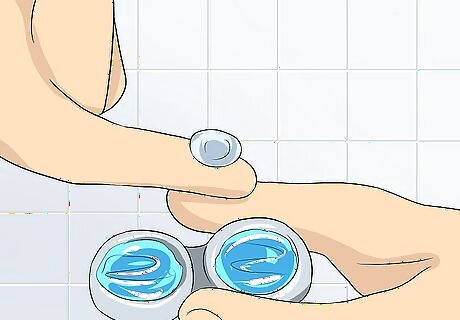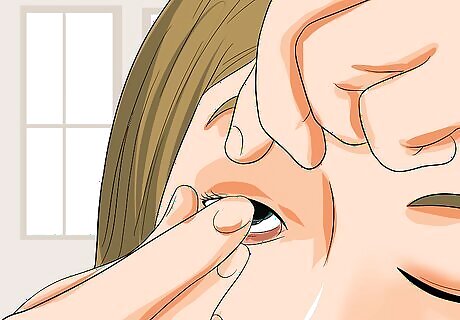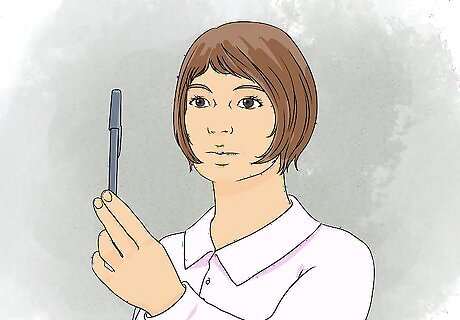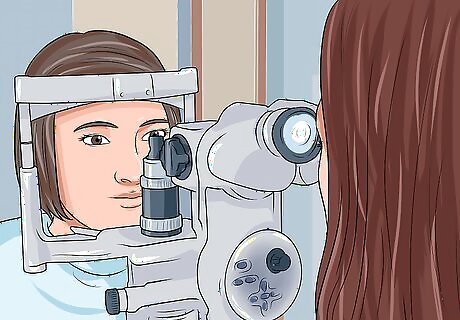
views
X
Trustworthy Source
National Health Service (UK)
Public healthcare system of the UK
Go to source
To treat astigmatism, get corrective lenses that help your eye to focus and see the world more clearly. You can also try doing eye exercises to strengthen your eye function. For a more permanent option, get laser eye surgery to correct the astigmatism.
Getting Corrective Lenses

Speak to your optometrist about getting eyeglasses. Eyeglasses are a good option for correcting astigmatism. They help to correct the irregular curve of your cornea and allow your retina to focus properly. Your optometrist will determine your glasses prescription so you can buy glasses to correct the astigmatism.

Try on eyeglasses to find ones that are comfortable and fit your face. Go to an eyeglasses store and try on glasses in person. Make sure the glasses feel comfortable when they sit on your nose and that they complement, rather than overwhelm, your face. You should feel confident when you wear them. If you want to buy eyeglasses online, you will need your prescription. Use a virtual try-on tool to see how the glasses will look on your face before you order them. Some eyeglass companies will offer to send you free samples of their frames so you can find the right one for you.

Keep your eyeglasses clean. Spray an eyeglass cleaner on the lenses and wipe them down with a smooth, dry cloth. Clean your glasses once a day, or several times a day, so your vision is not obscured by dust or dirt when you wear them. Keep your glasses in good condition by getting the screws in the arms tightened when needed. Your glasses should always sit flush against the sides of your face, with the arms on the glasses straight and even. Store your eyeglasses in a hard shell case to protect them and keep them in good repair.

Get toric contact lenses if you’d prefer not to wear eyeglasses. To correct astigmatism, you will need special toric contact lenses, rather than standard contact lenses. They are a good option if you don’t like wearing glasses all the time and you are comfortable putting contact lenses in your eye. Your optometrist may recommend contact lenses if you play a lot of sports or are very active and do not want to have to worry about wearing eyeglasses. Children 12 years and older can wear contact lenses. However, they may need the help of a parent to put them in. Irregular astigmatism is more likely to be treated with hard contact lenses, whereas regular astigmatism is more likely to be treated with glasses, soft contact lenses, or laser surgery.

Put the contact lenses in correctly. Wash your hands and then remove the contact from the case. Place it on your index finger. Pull your upper and lower eyelids away from your eye with the other hand. Carefully place the contact on your eye. Release your eyelid and blink to keep the contact in place. If you have trouble putting in the contact lenses, speak to your optometrist for guidance. It may take some practice to get the hang of it.

Keep the contact lenses clean. Use a hard shell case to store the contact lenses and keep them in specialized cleaning solution. Look for cleaning solution made specifically for contact lenses at a medical supply store or online. Replace the cleaning solution every time you use the lenses so they stay clean. Get a new hard shell case every 3 months to ensure the lenses do not get dirty.
Doing Eye Exercises

Do a focusing exercise. Sit in a comfortable position and focus on a book or text, holding it in 1 hand. You can also look at an eye chart on the wall, if available. Shift your gaze to a different object in your other hand, such as another book or a playing card. Then, shift back to the original text. Do this several times to get your eyes used to focusing between 2 different objects. Keep your eyes relaxed during this exercise. If your eyes start to get sore, take a break. Do this exercise for 4-5 minutes a day. This exercise can help you to focus and refocus your eyes without them getting tired, which can improve your astigmatism.

Try doing an eye exercise with a piece of paper. Take a piece of thick paper that covers both of your eyes. Tape the paper to your forehead, just above your nose. The paper should block your ability to see in front of you, but allow you to still see out of the corners of your eyes. Raise your hand to 1 side of the paper. Focus on your hand without moving your head. Keep your eyes relaxed as you focus on your hand. Place your hand on the other side of the paper. Try focusing on your hand without turning your head. Repeat this exercise on either side for 1-2 minutes or until your eyes get tired. Do the exercise once a day. This exercise can help to strengthen your peripheral vision, which tends to be poor when you have astigmatism.

Practice keeping your head straight, rather than tilted to the side. If you have astigmatism, you may find you tilt your head to 1 side to help correct the issue. Try to be conscious of this habit and correct it by keeping your head straight. Tilting your head to 1 side can lead to neck issues and prevent your astigmatism from getting better.
Getting Laser Eye Surgery

Get a referral for a specialist eye clinic from your optometrist. Laser surgery will use beams of light to reshape your cornea so you no longer have astigmatism. This procedure must be done at a specialist eye clinic by a surgeon trained in laser eye surgery. Laser eye surgery can range in price from $300 to $4,000 USD per eye. The cost depends on how experienced your surgeon is and the severity of your astigmatism. Your health insurance may not cover laser eye surgery. Contact your insurance provider for more information.

Learn the possible risks of laser eye surgery. This procedure is considered safe and low risk. In rare cases, you may develop dry eyes, double vision, glare, and vision loss. However, these issues usually clear up as you recover from the surgery. In some cases, your surgeon may under-correct your eyes, where your cornea is not repaired enough to fix your astigmatism. If this occurs, they can repeat the surgery and make sure your cornea is fully corrected.

Allow the eye surgeon to perform laser eye surgery. The surgery will be done at the eye clinic and will take 20-30 minutes total. You will be given medication so you can relax as the surgery is performed. You will also be given numbing eye drops so you do not feel anything during the procedure. If you are getting laser surgery in both eyes, the surgeon will likely complete surgery on both on the same day.

Recover after the surgery. Most people can drive and return to work 1-2 days after getting laser eye surgery. Your doctor will check up on you the day after your surgery and you will need to have regular check ups for the first 6 months of recovery. Issues like dry eyes, double vision, and glare should clear up within several weeks. Protect your eyes from injuries by wearing sunglasses outside and avoiding contact sports as they heal. Most people recover fully from laser eye surgery within 6 months. After 6 months, your doctor will reassess your sight to confirm you no longer have astigmatism.




















Comments
0 comment